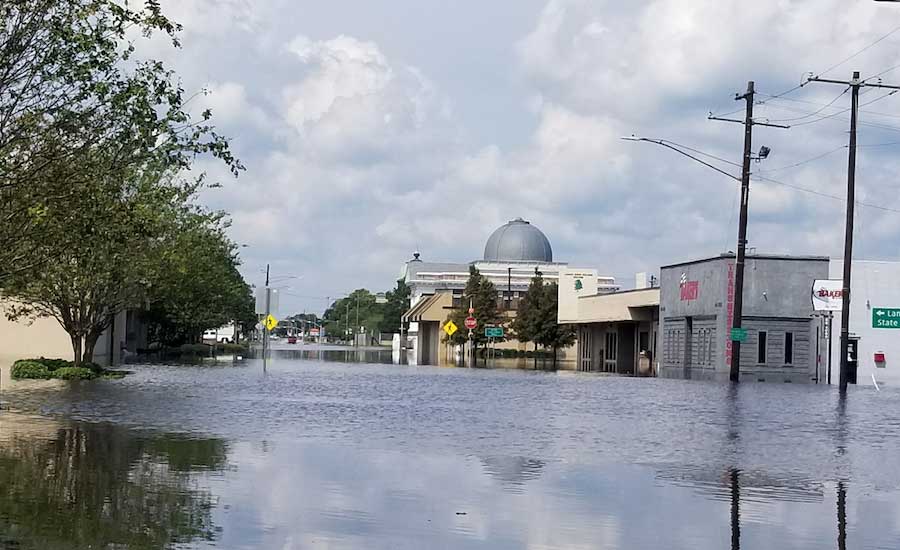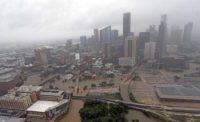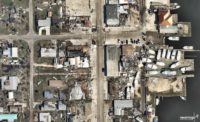Contractors in south Texas are helping emergency crews clear roads and restore services to storm-battered towns along the Gulf Coast, despite widespread damage to many of their own homes and businesses, says Amy Lee, executive director of the South Texas Chapter of the Associated General Contractors in Corpus Christi. “We have about 90% of the power back on in Corpus,” she says.
But some coastal towns such as Port Aransas and Rockport, where the storm first made landfall, “had only about 20% of their power back” as of Labor Day weekend, Lee said on Sept. 5. Although the main roads are passable, utility poles are splintered and down all along the coast, and generators are supplying most of the power to the few businesses that are open. Lee says that she has not yet polled her members to determine the extent of damage to their own operations. “But we will rebuild stronger,” she adds.
The amount of damage in these areas is extensive and, in many cases, is requiring complete replacement of utility poles, power lines and other equipment,&rdquo
– AEP Texas, a utility
The Dept. of Energy says about 60,000 people in Texas are still without power. “The amount of damage in these areas is extensive and, in many cases, is requiring complete replacement of utility poles, power lines and other equipment,” electric utility AEP Texas said in a statement Tuesday. “Crews continue to use specialized equipment such as cranes and all-terrain vehicles to address the remnants of earlier flooding. Working conditions have proved challenging especially with swarms of ‘super-sized’ mosquitos.”
Stephen Lucy, owner and managing partner at JQ Engineering, says the firm mobilized four of its nine-person staff in Houston on Sept. 1 under a FEMA contract that involves the review of water and wastewater infrastructure systems for the city of Houston. This work is under a contract AECOM has with the agency.
“What we did starting Friday through yesterday was review wastewater plant facilities and also the collection system, and then starting today we have some engineers involved in review of the water treatment plant side for the city of Houston,” Lucy explains. “So it’s multi-company, multi-engineering discipline review of the plants and we’re on there from a structural engineering standpoint.”
Some of these facilities are seeing scouring issues, similar what occurred at highway bridges in the area, Lucy adds.
However, the levee systems around these plants appear to have held. “All in all, structurally they haven’t really seen anything within the plants. I think as they start to bring them up, I think that’s when other systems may have problems within those plants. Not structurally, but other system-related issues,” Lucy says.
JQ had just completed a structural rehabilitation project of the Marine Science Facility in Port Aransas for the University of Texas on the Wednesday before Harvey struck, “so we’re trying to find out what the status of that is,” Lucy says. “We’ve advised them that we probably need to review it again—it’s their marine research facilities right on the barrier island, and so we anticipate that it probably sustained some additional damage.”
Farther to the north, Pearson Construction Inc., a Waco, Texas-based general contractor, and Johnson Roofing, Robinson, Texas, are working closely with the San Antonio Food Bank to collect and deliver truckloads of nonperishables to towns and rescue centers along the coast. The first deliveries are scheduled for early this week.
Jerry Nevlud, president and CEO of the Houston Chapter-AGC says he “has no firm grasp” yet on how much damage his member firms sustained in the flood.. “Houston has had its share of bad weather,” Nevlud says. “But there are places around here under water that have never flooded before.”
Water Issues in Beaumont, Texas
The municipal water system in Beaumont, Texas, is operational again, but it “comes and goes, and is not potable yet,” says Jennifer Gordy, executive director of AGC of Southeast Texas. “We also have lots of damaged schools, including some that were just completed, and many of those folks are contacting the contractors directly for help,” Gordy says. Exxon Mobil says its engineers are working with city engineers to get the Beaumont system fully operational.
According to the Texas Commission on Environmental Quality, of the 2,000 drinking-water systems affected by Harvey, 37 are shut down, while 188 have boil-water notices. Wastewater systems were hit harder, with 425 plants shut down, according to TCEQ. The American Water Works Association, as it did after Hurricane Katrina, took the lead to set up a cooperative system where other water utilities can ask for equipment like pumps and generators and for help.
One Beaumont firm, commercial and industrial contractor H.B. Neild & Sons, said the flood waters inundated its offices and damaged “quite a bit of equipment,” but the company was operational within a few days after the storm. “We’ve had to get really creative in dicing up the few resources we have,” says Thomas Neild, vice president.
He says most of the 70 employees of the family-owned firm, started by his great grandfather in 1932, suffered some degree of damage to their homes. Neild, who lives outside the city near the fast-rising Neches River, had to evacuate his own family, including a 10-day-old baby, to higher ground.
“Now we’re taking care of the families of our employees,” Neild says. “That’s priority one. A lot of our guys lost everything, but they showed up in their hard hats as soon as they could get out [of the flooded areas] and were eager to work.”
He says the company could return quickly to operational status in part because of the hurricane-preparedness planning it put in place last spring.
“We pulled our equipment back to the office, secured jobsites and knew ahead of time where everyone would be in the event of an evacuation,” he says. “So, we are up and running, though it’s not as pretty as it was last month.”
But most firms along the Gulf Coast are still taking stock on their losses and assessing immediate needs. “We don’t know exactly what we need yet, until we hear from more of our members,” Gordy says.
Brian Turmail, a spokesman for AGC of America, said his group is also still tracking members and seeing where it can help.
The Structural Engineers’ Association of Texas has a program for disaster response that was activated last week, with the first deployment to Port Aransas.
“What we’ve told our staff is if they want to take part in any of these volunteer responses or requests, we’re more than happy to do that, and we’re paying all of their time,” Lucy says.
Hurricane Harvey's Long-Term Impact
Elsewhere, recovery is occurring, although very slowly. The state’s major ports in Galveston and Houston are open with restrictions, eight of the refineries impacted by the storm are beginning the process of restarting, which the Energy Dept. says could take several weeks. Exxon Mobil says its Beaumont refinery remains closed because one section of the refinery is still flooded. Some of the refineries are affected by lack of pipelines, rail or ships.
The Environmental Protection Agency says it has conducted assessments at 41 sites impacted by the storm using aerial images and determined that 13 sites had been flooded or are experiencing damage. Eleven sites have not been accessible.
Harvey is going to impact on the overall construction market in Texas and the Gulf Coast region, Lucy says. “It’s going to absorb so much building material and resources that there’s going to be a tremendous impact on other projects that are going on that weren’t impacted directly by the storm. Projects are going to have to be redesigned to fit to the smaller scope because construction costs are going to go up so much,” he says.
“This is such a huge area …, I don’t think we’re going to know for some period of time what the total impact is to some of our clients and just to that area to begin with,” he says. “Time will tell, but I think it’s going to start happening fairly quickly.”








Post a comment to this article
Report Abusive Comment